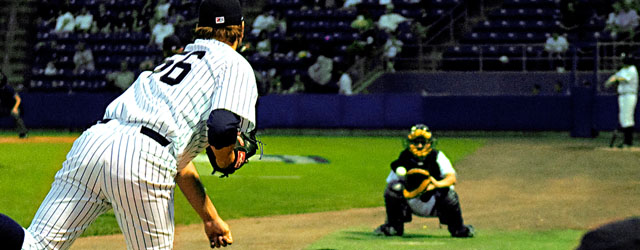
In my previous post, the focus point was on throwing quality bullpens by having a plan of attack, making the bullpens as game-like as possible, always eyeballing for having the proper mechanics, and constantly striving to throw strikes. Don’t forget, the best pitch a pitcher can throw is STRIKE ONE. If coaches and pitchers maintain these suggestions in their bullpens, success will translate to the games.
Bullpens are thrown during different times of the year. Bullpens thrown before the season are sessions determined to get pitchers in throwing shape, improve the expertise of the pitchers’ pitching repertoire, and definitely increase the pitch sharpness for game action. During the season, pitchers should be focusing on maintaining their performance, working on slight weaknesses, building on their strengths for their next outing, and striving to perfect their performance for the next outing.
Here are some suggestions for varying your bullpen sessions:
1) Back-to-Back Pitch Bullpen – In this bullpen, the pitcher will throw the same pitch to the same location two times in a row. What is the purpose? If pitch one did NOT accomplish the desired goal, then the next one needs to improve. If pitch one achieved the desired goal, can the pitcher repeat the performance with maybe even better results?
The Back-to-Back Pitch Bullpen Chart might look something like the following sample:
Windup vs. RHP: Stretch vs. LHP
1)FB – DA 1)FB – DA
2)FB – DA 2)FB – DA
3)FB – HT 3)FB – HT
4)FB – HT 4)FB – HT
5)CH – DA 5)CH – DA
6)CH – DA 6)CH – DA
7)BB – DA 7)BB – DA
8)BB – DA 8)BB – DA
Locations of Down-and-Away could be changed depending on whether your pitcher is a right-hand pitcher or left-hand pitcher. For instance, right-hand pitchers would probably desire the breaking ball under the hitter’s hands instead of Down-and-Away. Also, our goal in the High-and-Tight Fastball is to “crowd” the hitter and not allow his hands to extend. One of the successes of this type of bullpen is that pitchers have better success at throwing back-to-back pitches in the same location when we desire this sequence in a game.
2) 2-out-of-3 Strike Bullpen – In this bullpen, the goal for the pitcher is to hit the desired location twice within three pitches. One of our constant goals is pitching ahead in the count and if pitchers can command the zone with strikes twice within the first three pitches, they regularly sit at a 1-2 count and baseball experts know the advantage sides heavily with the pitcher in his battle with the hitter.
The 2-out-of-3 Strike Bullpens might look something like the following sample:
1)FB – DA 1)BB – DA 1)FB – HT
2)BB – DA 2)BB – DA 2)FB – DA
3)CH – DA 3)FB – DA 3)BB – DA
The organization of the bullpen’s pitches depends on each pitcher and his pitching ensemble. One pitcher might be a hard-throwing guy whose focus would be the fastball, so early in the count, the emphasis would be on fastball command. If another pitcher is a breaking ball guy with a great change, we would ask him to get ahead with the “soft” stuff, and then use the fastball later in the count. By using various pitch sequences, pitchers can become more aware of their strengths and weaknesses, and learn to pitch to their game.
3) 1 inning – Game-like Bullpen – In this bullpen session, we “turn up” the competitive juices and have our hitters, standing in the box, call whether the pitch is a ball or strike. The catchers give signs to the pitchers, pitchers focus on being in the stretch only and they throw a 1 inning stint in the bullpen. Extra pitchers chart the session and tabulate the walks/strikeouts. The reason for our hitters playing the role of umpire, is they can learn to track pitches and tell the pitcher whether they “see” the pitch as a strike. The idea is to desire your pitchers to “pitch to contact,” not to strike out everyone. If our hitter believes the pitch is a strike, he would probably swing at the pitch. Pitchers are “wasting” less pitches, focusing on strike command and the overall scenario is very “game-like”. Pitchers might be “squeezed” by the hitters, but umpires might miss a call or two in a game, and the pitcher needs to handle it, move to the next pitch, and maintain his composure.
4) LIVE BULLPEN – The pitchers are heated up in the bullpen, throwing all of their pitches in a windup session, and then move to the mound to face live hitting in a 1-on-1 battle. The catcher calls the pitches, coaches directly behind the catcher (with a screen) play the role of umpire and the pitcher-hitter compete without fielders. The pitcher will compete with usually four different hitters, and we vary the hitters between right-handed hitters and left-handed hitters, young hitters and veteran hitters, power hitters and on-base hitters so that the pitchers can deal with all types. If we want to “extend” the pitcher’s pitch count, then the hitters go through the lineup twice. The value of this competitive session is for a “hands-on” approach – often times, coaching guidance can focus on pitch movement, location of the pitch, “using” the breaking ball to entice hitters to chase in the dirt, etc.
Leave a Reply